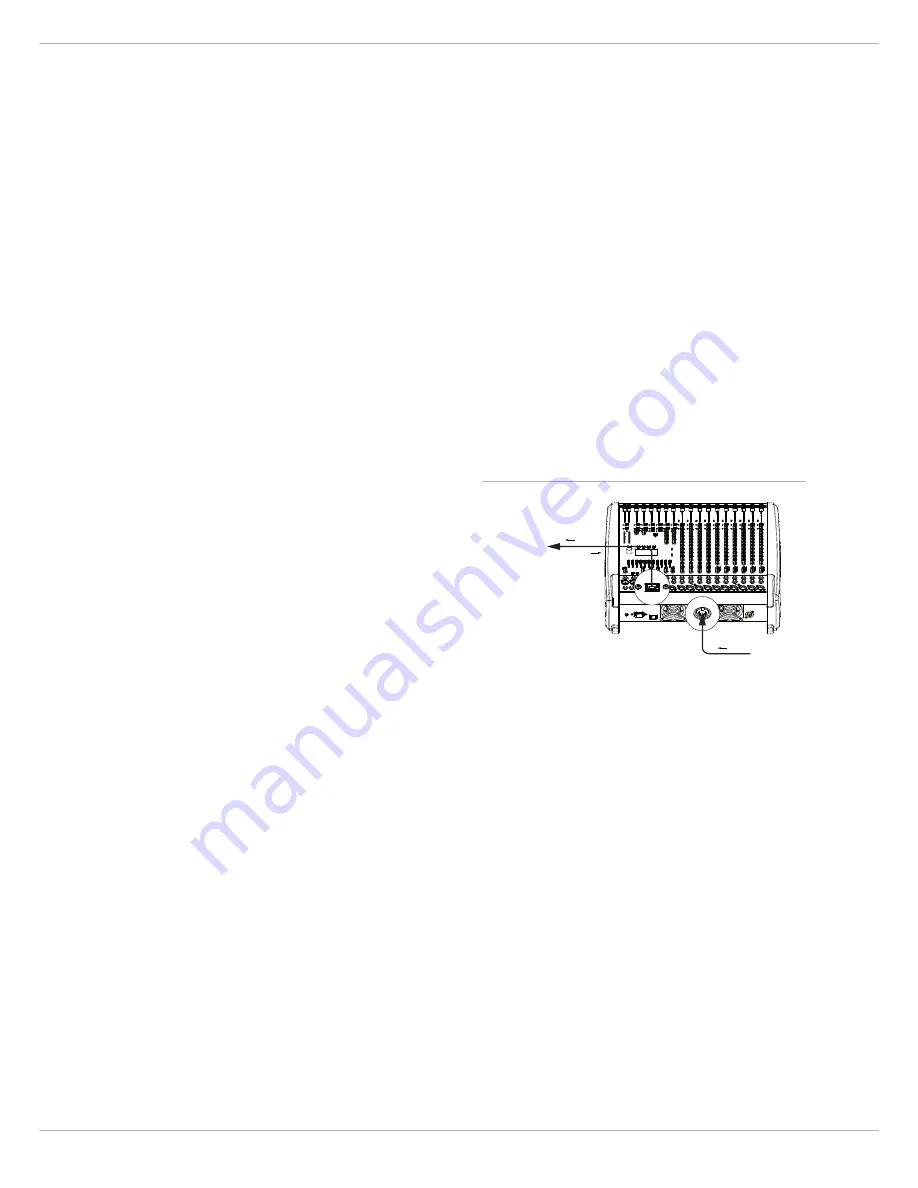
P
OWER
M
ATE
3
31
driver. ASIO is a standard, which has been established in
almost all applications of multi-channel sound interfaces.
The ASIO driver was automatically installed together with
installing the device driver, as described on page 29. For
assigning the sends to the playback channels of the Pow-
erMate, please mind the documentation of the software
program that you are using.
4.6 Example of usage (Recording)
In the following application, your PC/Mac is used for
recording while the PowerMate functions as premium A/
D converter, without the need for an external sound card.
LIVE
-
RECORDING
OF
EVENTS
The mixer master signal is transmitted to the PC on USB
channels 1-2 of the DIGITAL AUDIO INTERFACE. This is
the basic setting for a live recording of your event.
On USB channel 3 (or 4) the AUX (or MON) way is trans-
mitted to the PC. If the AUX or MON ways are not yet re-
served or occupied for monitoring, effect applications or
other purposes, you can use them instead to record two
additional signals, which then are available during post-
production of your recording. This, for example, provides
the possibility to enhance solo vocals or a solo inst-
rument at specific passages so that they stand clearly in
front of the mix. For that, you need to assign respective
input channels to the AUX/MON bus using the AUX/MON
controls.
A very recommendable option is to use the two ways in
order to record the signals of a stereo microphone posi-
tioned in front of the stage. Recordings, which are fed
only from the PA mixer, are often disappointing, because
audience reactions are completely missing and the sound
does not reflect the live performance. That is because of
the fact that particularly in small venues the acoustic out-
put or electrical signal of many musical instruments,
which by nature already have sufficient clout (such as
drums, electric guitar, etc.) gets reproduced only to a
slight degree or not at all via the public address system.
Conversely, sound recordings that only employ a room
microphone, very often sound indirect and especially the
vocals suffer from a lack of clearness and intelligibility.
The PowerMate offers the possibility to simultaneously
record both signal sources (mixer output and room
microphone) separate from each other. During post-pro-
duction of the recording you can comfortably match all
tracks in proportion to each other.
HINT: Make sure that during recording the signals of
the room microphones are not included in the
PA mix to prevent feedback. Therefore, the fad-
ers of the „room channels“ have to be pulled all
the way down. The AUX ways, nevertheless,
have to be operated in pre-fader mode in order
to feed the signal to the DIGITAL AUDIO INTER-
FACE.
4.7 MIDI tone generator and multi-
effect unit
As already explained, the PowerMate can be used to
transfer MIDI data for instance from a master keyboard to
a PC/Mac. Using appropriate software, such as a multi-
track recording application and suitable PlugIns (e.g. the
supplied Cubase LE software), the entire world of most
up-to-date sounds is always at your disposal. Due to the
efficiency of today's laptops, it is no longer a problem to
expand your personal sound library even in Live-use with
sounds that, a few years ago, were only to be found on so-
phisticated studio synthesizers. Connect your master
keyboard to the MIDI IN jack and select the MIDI INTER-
FACE as input for the tone generator in the software
application. The computer-generated sounds are trans-
mitted over one of the two USB stereo channel strips
back to the PowerMate. Using the faders, you can
comfortably adjust the volume level, as if you had con-
nected a keyboard with built-in tone generator to the ste-
reo line inputs.
The PowerMate offers similar options for the creation of
sound effects. The PC serves as an external, extremely
powerful multi-effects unit. Since the signal is fed from
the AUX way, the operation during mixing becomes as
simple as using the internal effects of the PowerMate.
The AUX way should be switched to post-mode. The
effect signal generated in the PC is again added to the
overall mix via USB stereo channels 1-2 and 3-4. The ste-
reo channel faders serve as FX-return controls.
Finally, it has to be mentioned that, depending on the
software and drivers, some of the options described can
also be used in parallel. For example, you can use the four
recording channels of the PowerMate for live recording
and at the same time play back music from the same PC,
e. g. for stage performances.
Illustration 4-6: Using the PC/Mac as MIDI tone generator
(illustration shows PowerMate 1000-3)
Master Keyboard
USB to PC/Mac
MIDI
MIDI
EFFECTS
MIDI IN
Summary of Contents for PowerMate 600-3
Page 1: ...PowerMate3 PowerMate 600 3 POWERED MIXER Owner s Manual Bedienungsanleitung...
Page 2: ...POWERMATE 3 2...
Page 14: ...POWERMATE 3 14...
Page 16: ...POWERMATE 3 16...
Page 18: ...POWERMATE 3 18...
Page 39: ...POWERMATE 3 39...
Page 50: ...POWERMATE 3 50...
Page 52: ...POWERMATE 3 52...
Page 54: ...POWERMATE 3 54...
Page 78: ...POWERMATE 3 78 7 1 Dimensions...
Page 79: ...POWERMATE 3 79 7 2 Block Diagram...
Page 81: ...POWERMATE 3 81 Notes...
Page 82: ...POWERMATE 3 82 Notes...
Page 83: ...POWERMATE 3 83...






























